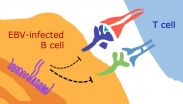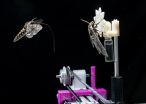(Press-News.org) Though many people believe they can recognize when someone is lying, detecting deception is difficult. Accuracy rates in experiments have proven to be only slightly greater than chance, even among trained professionals.
But a new study published recently in Proceedings of the National Academy of Sciences (PNAS) finds that groups are consistently more accurate in distinguishing truths from lies than one individual is.
In 'Group discussion improves lie detection,' by University of Chicago Booth School of Business Professor Nicholas Epley and Chicago Booth doctoral student Nadav Klein, the researchers designed four experiments in which groups consistently distinguished truth from lies more accurately, demonstrating that the group advantage in lie detection comes through the process of group discussion, not the product of a 'wisdom of crowds' effect.
In other words, groups were not simply maximizing the small amounts of accuracy contained among individual members, but were instead creating a unique type of accuracy altogether.
'We find a consistent group advantage for detecting small 'white' lies as well as intentional, high-stakes lies told for personal gain,' says Epley. 'This group advantage seems to come through the process of group discussion rather than statistical aggregation of individual opinions.'
According to the study, the modest accuracy rate of people who can detect deception is driven mostly by the tendency to detect truths, rather than lies. This has led other researchers to develop costly training programs that target individual lie detectors to increase accuracy. Epley and Klein test a different strategy: asking individuals to detect lies as a group.
'Existing research demonstrates that increasing incentives for accuracy among lie detectors does not increase accuracy, but that increasing incentives for effective deception among lie tellers make lies easier to detect. Therefore, we did not manipulate lie detectors' incentives to detect truth versus lies accurately, but instead asked participants to detect truths v. lies in low-stakes and high-stakes contexts for the lie tellers,' Epley says.
In the first two experiments, subjects watched videos of different statements from different speakers and guessed whether each statement was a truth or a lie, either individually or in three-person groups. The only difference between the two experiments was that in the second, researchers used different statements and also nearly doubled the sample size.
In both, results were replicated: groups were more accurate than individuals (61.7 percent and 60.3 percent group accuracy in Experiments 1 and 2, respectively, compared to 53.55 percent and 53.56 percent individual accuracy).
The third experiment tested whether the group advantage in lie detection applied to high-stakes and intentional lies. Groups were again more accurate, with 53.2 percent over 48.7 percent in individual accuracy. The fourth experiment focused on two underlying reasons groups could better identify deception than individuals: first, group discussion could identify the most accurate person within a group which increases accuracy through a sorting mechanism; and secondly, group discussion could elicit observations about the target that provide information needed to make an accurate assessment.
'Interventions to improve lie detection typically focus on improving individual judgment, which is costly and generally ineffective,' Epley says. 'Our findings suggest a cheap and simple synergistic approach of enabling group discussion before rendering a judgment.'
INFORMATION:
Contact:
Professor Epley
Nicholas.Epley@chicagobooth.edu
773-834.1226
Not all of America's most admired companies are killing it on social media. In fact, some are almost flat lining, according to a team of researchers.
Several firms on Fortune Magazine's list of America's most admired companies are failing to achieve basic social media standards, let alone best practices, according to Marcia DiStaso, associate professor of public relations, Penn State.
"We were surprised that not all the companies had a Twitter account, for instance, and not every company had a Facebook page, or a YouTube page," said DiStaso. "There are top companies ...
Beverly, MA, June 11, 2015 - Cardiac surgeons often "crack open" the flat bone that forms the middle front section of the chest, known as the sternum, in order to reach important structures. When a sternal wound infection (SWI) occurs, serious complications and even death may result. Implanting antibiotic-laden sponges between the sternal halves before closure has been adapted to prevent infections. While a recent report questioned this practice, a meta-analysis in The Journal of Thoracic and Cardiovascular Surgery, the official publication of the American Association for ...
Nursing home residents with dementia are less likely to be apathetic if they live in an appropriately stimulating environment, according to nursing researchers.
Nearly half of all residents in nursing homes have dementia, according to a 2013 report by the Centers for Disease Control. Apathy is one of the most common neurobehavioral symptoms in dementia, with about 90 percent of older adults with dementia experiencing it. Those with mild dementia will decline more quickly into severe dementia if they also suffer from apathy, making it important to help them stay engaged. ...
Lehigh University engineers, materials scientists and chemists will present their innovative breakthroughs to a national showcase of investors and industrial partners at the TechConnect 2015 World Innovation Conference and National Innovation Showcase in Washington on June 14-17.
Working at the junction of engineering and health, the Lehigh innovations include a nanoscale device that captures tumor cells in the blood, a bioengineered enzyme that scrubs microbial biofilms and the creation of a safe and efficient chemical reagent that is stable at room temperature.
These ...
DARIEN, Ill. -- A new study suggests that bright light at the end of a night shift may have potential as a countermeasure to improve driving performance, particularly for low light work environments and commutes that occur before dawn.
Results show that temperature, subjective alertness and psychomotor vigilance performance decreased significantly across the night. Bright light significantly suppressed melatonin, but did not improve subjective alertness or psychomotor vigilance performance. Sleep deprivation markedly increased incidents, accidents, and the average lane ...
LEXINGTON, Ky., June 12 -- In a new University of Kentucky study published today in Cell Reports, a leading scientific journal in cell biology, researchers describe a new molecular mechanism that contributes to age-related macular degeneration (AMD) due to accumulation of excessive iron within the cells of the retina.
Cells of the body use iron in dozens of normal metabolic processes. However, excessive iron or 'iron overload' can be very damaging to cells and tissues, and is implicated in numerous diseases, including AMD.
'The reason that cells die due to iron ...
About 90% of adults worldwide are infected with Epstein-Barr virus, or EBV. The virus infects B cells (the white blood cells that make antibodies) and can contribute to B-cell-derived cancers, but in most people it remains dormant--a state scientists refer to as "latent infection"--for the rest of their lives. A study published on June 11th in PLOS Pathogens sheds new light on why the infected person's immune system cannot eliminate EBV, or the associated cancer risk.
Interested in the immune response against EBV, Andreas Moosmann, from the Helmholtz-Zentrum in Munich, ...
It's difficult enough to see things in the dark, but what if you also had to hover in mid-air while tracking a flower moving in the wind? That's the challenge the hummingbird-sized hawkmoth (Manduca sexta) must overcome while feeding on the nectar of its favorite flowers.
Using high-speed infrared cameras and 3-D-printed robotic flowers, scientists have now learned how this insect juggles these complex sensing and control challenges - all while adjusting to changing light conditions. The work shows that the creatures can slow their brains to improve vision under low-light ...
ANN ARBOR--Variations in the amount of oxygen in Earth's atmosphere significantly altered global climate throughout the planet's history. Efforts to reconstruct past climates must include this previously overlooked factor, a new University of Michigan-led study concludes.
Oxygen currently comprises about 21 percent of Earth's atmosphere by volume but has varied between 10 percent and 35 percent over the past 541 million years.
In periods when oxygen levels declined, the resulting drop in atmospheric density led to increased surface evaporation, which in turn led to ...
This news release is available in Japanese.
Water injected into an inactive fault can cause aseismic slip along the fault -- movement without detectable earthquakes -- that may then indirectly lead to micro-earthquakes. That's the result from a controlled experiment by Yves Guglielmi and colleagues, who observed these events in real time after injecting fluid into a natural fault near an underground experimental facility in southeastern France. Researchers are intensely interested in this type of induced seismicity, especially with a rise in earthquakes caused by ...

